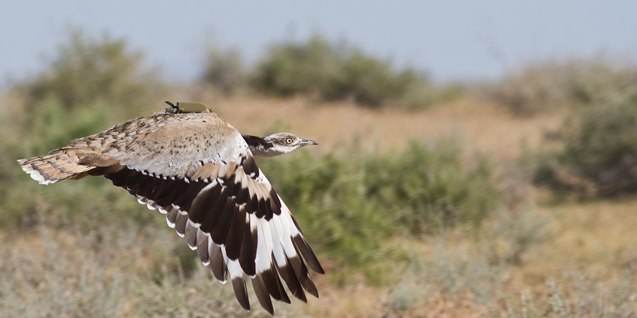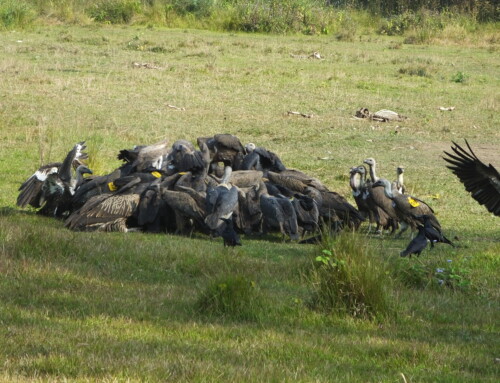Do captive-bred Asian Houbara replicate wild migration strategies?
LINKED PAPER
Comparative migration strategies of wild and captive-bred Asian Houbara Chlamydotis macqueenii. Burnside, R.J., Collar, N.J. & Dolman, P.M. 2017. IBIS. DOI: 10.1111/ibi.12462. VIEW
Captive-breeding and release of Asian Houbara bustards Chlamydotis macqueenii is used and promoted as a single-solution approach to offset the decline of the species and preserve the long-running tradition of Arab falconry. However, considering the scale of investment in releases, there is actually very little publicly available evidence that released birds contribute to the long-term conservation of the species. As part of our ongoing research at the University of East Anglia, undertaken in collaboration with BirdLife International and the Emirates Bird Breeding Center for Conservation (EBBCC) in Uzbekistan, we have been seeking to generate evidence to answer the key conservation questions that have remained unaddressed around the use of captive breeding in Houbara population management. One particular issue we have been investigating is the suitability of released captive-bred birds for supplementing extant wild populations. Of course, as a baseline comparison, we need to understand if released captive-bred birds perform in similar ways to their wild counterparts.
One of our top aims was to establish if wild migration behaviours are retained by birds bred in captivity. We compared the migration strategy of captive-bred released Houbara with both wild adult and wild juvenile Houbara. Wild juvenile Houbaras separate from their mothers after two months and undertake migration alone, as naïve first-time migrants, and thus they are of similar age and with similar lack of migration experience to the captive-bred birds. We used GPS satellite-tracking to follow the migrations of 39 wild adults, 10 wild juveniles and 29 captive-bred birds, all tagged in the Bukhara region of Uzbekistan (Fig. 1).

The captive-bred released Houbara (CBR) proved to be similar to wild juveniles in all but two parameters, autumn departure date and wintering latitude. Released birds started autumn migration on average 20.6 days later than both wild juvenile and wild adults (Fig. 2). Subsequently, released and wild juveniles migrated at the same rate (74 km/day), which was slower than the wild adults (165 km/day). The released and wild juveniles then continued migrating after most adults had reached their wintering grounds. Thus both wild juveniles and released birds stopped at the same time, but later than adults. But as a consequence of their late departure, CBR failed to travel as far as wild birds (the second difference in parameters), wintering on average 470 km closer to the breeding grounds (38% closer, in Turkmenistan, northern Iran & Afghanistan), whereas wild birds tended to reach southern Iran and Pakistan (Fig. 2 & 3). For the small sample of captive-bred birds that we were able to follow on subsequent migrations, they remain faithful to their first wintering sites but were otherwise similar to wild adults in their migration strategies.


Two questions arise from these results: first, what is the cause of the CBR’s late departure? And second, what will be the effect of the more northerly wintering sites on CBR survival and productivity? At present we can only speculate on the answers. Concerning the delayed departure, the muscular and energetic condition needed for long-distance migration may take longer in CBR birds, given that they must adapt to new food sources in the desert after release. Possibly also these birds fail to integrate into small groups of wild birds, which may socially transmit the start of migration. Answering this first question is challenging given the difficulties of observing individuals in the wild, but we may discover the answer to the second question with long-term monitoring to establish the costs and benefits of winter-site choice in wild and captive-bred birds. At the moment, although the sample sizes for wild juveniles is small, survival through the first winter does appear to be lower for captive-bred birds than wild juveniles, and this could be one cost of failing to replicate wild strategy.
This is the first study to compare the migratory strategy of these Asian Houbara cohorts. If you are interested in reading more about the use of captive breeding and release in Houbara conservation, I have written previously in the BOU blog about the role of releases in sustainable hunting, which you can read here.
Reference
Burnside, R.J., Collar, N.J. & Dolman, P.M. 2017. Comparative migration strategies of wild and captive-bred Asian Houbara Chlamydotis macqueenii. IBIS. DOI: 10.1111/ibi.12462. VIEW
Image credit
Featured image: Wild male Asian Houbara Chlamydotis macqueenii flying with a satellite tag © R.J. Burnside
If you want to write about your research in #theBOUblog, then please see here.





